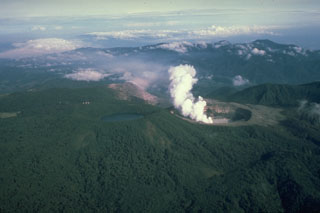Report on Poas (Costa Rica) — 18 June-24 June 2025
Smithsonian Institution / US Geological Survey
Weekly Volcanic Activity Report, 18 June-24 June 2025
Managing Editor: Sally Sennert.
Please cite this report as:
Global Volcanism Program, 2025. Report on Poas (Costa Rica) (Sennert, S, ed.). Weekly Volcanic Activity Report, 18 June-24 June 2025. Smithsonian Institution and US Geological Survey.
Poas
Costa Rica
10.2°N, 84.233°W; summit elev. 2697 m
All times are local (unless otherwise noted)
The Observatorio Vulcanológico y Sismológico de Costa Rica-Universidad Nacional (OVSICORI-UNA) reported continuing gas-and-steam emissions with occasional minor amounts of ash at Poás during 18-24 June. Significant amounts of gas-and-steam emissions continued to be emitted, particularly from Boca A. On 18 June sulfur dioxide emissions averaged 273 tons per day (t/d), though they were as high as 1,500 t/d towards the second half of the week; overall, though levels remained high, there has beenwas a decreasing trend in sulfur dioxide emissions during over the previous few weeks, though levels remained high. Gas component ratios indicated less of a magmatic input. Incandescence continued to be visible and detected in infrared webcam views at Boca A vent. The hyperacid lake over Boca C continued to rise, notably on 15 June during a period of heavy rain. Minor amounts of ash in the gas-and-steam plume were visible in webcam images during 1725-1900 on 22 June. The plumes rose 500 m above the crater rim and drifted W. The Comisión Nacional de Emergencias (CNE) lowered the Alert Level to Yellow for Parque Nacional Volcán Poás and district of Toro Amarillo in the Canton of Sarchí (including the Desagüe, Agrio, Anonos, and Gorrión river basins) on 18 June due to decreasing activity. Additionally, the districts of Grecia, Zarcero, Naranjo, Poás, Sabanilla, Sarapiquí, and Rio Cuarto were no longer under “alert.” The Parque Nacional Volcán Poás remained closed. The Alert Level remained at 2 (the second lowest level on a four-level scale) and the Aviation Color Code remained at Yellow (the second lowest color on a four-color scale).
Geological Summary. The broad vegetated edifice of Poás, one of the most active volcanoes of Costa Rica, contains three craters along a N-S line. The frequently visited multi-hued summit crater lakes of the basaltic-to-dacitic volcano are easily accessible by vehicle from the nearby capital city of San José. A N-S-trending fissure cutting the complex stratovolcano extends to the lower N flank, where it has produced the Congo stratovolcano and several lake-filled maars. The southernmost of the two summit crater lakes, Botos, last erupted about 7,500 years ago. The more prominent geothermally heated northern lake, Laguna Caliente, is one of the world's most acidic natural lakes, with a pH of near zero. It has been the site of frequent phreatic and phreatomagmatic eruptions since an eruption was reported in 1828. Eruptions often include geyser-like ejections of crater-lake water.
Sources: Observatorio Vulcanologico y Sismologico de Costa Rica-Universidad Nacional (OVSICORI-UNA), Comisión Nacional de Prevención de Riesgos y Atención de Emergencias (CNE)

